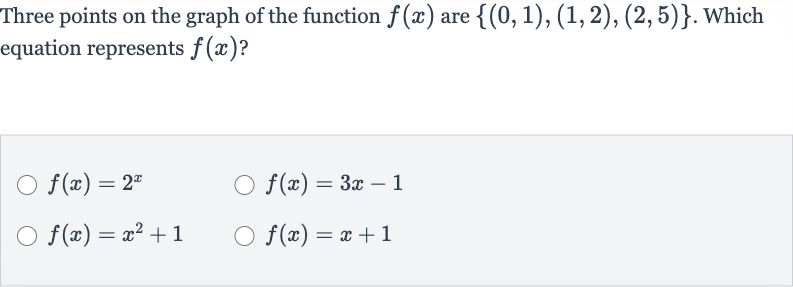Full solution
Q. Three points on the graph of the function are . Which equation represents ?
- Test : Let's test each given function with the points provided to see which one fits all three points.First, we will test the point with each function.
- Test : Testing with the point :. This matches the y-value of the point .
- Test : Testing with the point :. This does not match the y-value of the point , so this function is not a match.
- Test : Testing with the point :. This matches the y-value of the point .
- Test : Testing with the point :. This matches the y-value of the point .
- Test : Now, let's test the point with the remaining functions that matched the first point.
- Test : Testing with the point :. This matches the y-value of the point .
- Test : Testing with the point :. This matches the y-value of the point .
- Test : Testing with the point :. This matches the y-value of the point .
- Test : Testing with the point :. This matches the y-value of the point .Finally, let's test the point with the remaining functions that matched the first two points.
- Test : Testing with the point :. This matches the y-value of the point .Finally, let's test the point with the remaining functions that matched the first two points.Testing with the point :. This does not match the y-value of the point , so this function is not a match.
- Test : Testing with the point :. This matches the y-value of the point .Finally, let's test the point with the remaining functions that matched the first two points.Testing with the point :. This does not match the y-value of the point , so this function is not a match.Testing with the point :. This matches the y-value of the point .
- Test : Testing with the point :. This matches the y-value of the point .Finally, let's test the point with the remaining functions that matched the first two points.Testing with the point :. This does not match the y-value of the point , so this function is not a match.Testing with the point :. This matches the y-value of the point .Testing with the point :. This does not match the y-value of the point , so this function is not a match.

